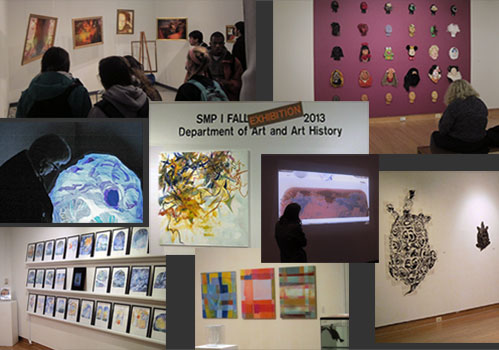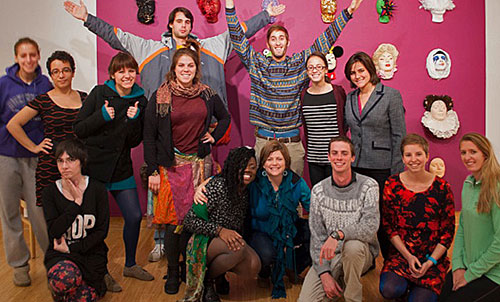Henry Bernstein

Paige Burger
Breathing

Relationships are the most important component of the human existence; values within ourselves promote our understanding of humanity. Through photography Nan Goldin produced candid images telling compelling stories of the subjects within. With vivid imagery, her cibachrome prints demonstrate a variety of relationships. Her photographs evoke emotion, they make you feel as though you are in the same room, or can recall a similar memory. I want to evoke strong emotional awareness in my photographs. However, like Diane Arbus, I enjoy staging, or recreating moments. The photographs, Franko, Sam, Jo and Hands are all recreated moments or memories that display particular internal dialogues. Paula is the only candid photograph. Each picture is superimposed with another; in this case all are combined with long exposure landscapes. Without applying a specific narrative I am attempting to evoke strong emotional awareness, among self and others.
Breathing is a framed installation that invites the viewer to climb into the space. Frames are simple objects that have grand implication. They are rich with history, intention, care and purpose. I collect frames, either by finding, thrifiting or receiving. I leave the frames around my studio so that I am constantly in visual engagement with their physical attributes. The frames in this installation were thrifted and received prior to the photographs being taken. When I look at images, I am always thinking about where they belong. Different photographs were committed to different frames at different times during the building of Breathing.
Natalie Cunningham

In my first semester of my SMP, I've narrowed my focus to the implementation of 2D frame-by-frame animations projected into a gallery space. I am also experimenting with sculptural elements, investigating the interplay between the sculpture existing as a frame for the animations, and the animations bringing movement and life to the sculptures. My installations involve hand drawn digital animations mapped tightly onto sculptural forms in a way that gives them life and motion. In this act of creation I am forming physical microcasms that act as a stage for me to play out my curiosities, anxieties and ventings. Right now I’m working exclusively with looping gif animations, as I enjoy building off of their limitations -- the brevity of a gif and its endless repetition lends it a stability that can feel either calm or stifling.
Anuli Duru
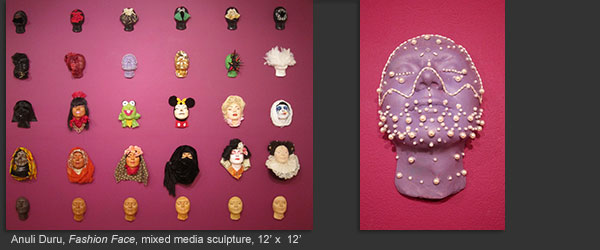
From traditional African attire to Chinese dress, to European Runway Couture, the way in which fabric is manipulated has shaped the perception of the self and formed statues of identity. Whether it is the type of material, the availability, or the quality, the ways in which we fashion these elements into clothing have come to define and almost speak for the human condition. Fashion can indicate not only a sense of cultural and ethnic identity but it can also speak of our age, our social class. It can characterize our emotions, and it can even project a kind of societal image or personality overtop our own individual personalities. The power in fashion is undeniable: it defines so much of who we are, sometimes even before we have a chance to do that for ourselves.
The thirty some faces on the wall represent the transformation of identity and how, as we grow and develop in our society, we begin to lose our originality as it is masked by culture, pop culture, materialism, and even by the clothes we wear. We arrive into this world completely nude, untouched, and original as represented by the bottom row of faces in the 6 different skin colors. Yet as we develop within our culture, we assume ethnic and cultural identities as represented by the next row. The third row projects how our identities are then transformed by media and pop culture. And from pop culture and societal influences, we learn to become material orientated, thus we are further transformed by accessories, trends, and materials. Eventually, we become so entangled with societal influences that our identities become like materials and the clothing we wear—always changing and always transforming us.
Rachel Heiss
Leftovers
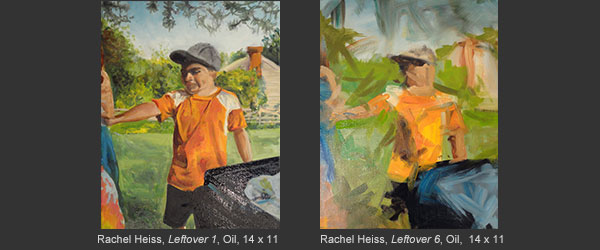
As technology progresses and becomes more accessible, photography has become an overwhelming system of storage for our memories. Photographs were once intended to be lasting, tangible, images. Now photographic images are more disposable, unwitting snapshots of any and every moment we feel the need to preserve. I believe that the impulsive need to conserve moments in time via the preservation of images could be a symptom of a larger problem in our society, resulting in a lack of focus and meaning during those actual moments.
Through paint, I am asking the viewer and myself to focus and find something meaningful in such a hasty photo. In my work, I use one of the many “leftover” photos in my phone—the ones that weren’t posted, printed, or deleted. I paint this image over and over as a way to reference the abundance of these types of photos made possible by digital memory storage. The images gradually abstract, representing how our concern for capturing moments in time is subverted by devices that actually take us out of the moment. Paintings are typically important commodities. I painted a one of my leftover images in order to bring attention to forgotten pictures and lost memories due to the need to preserve. Through painting, I find meaning in disposable aspects of our culture.
Rachel McDonald

I am interested in exploring the relationship between color and space with each painting that I make. The action of making a painting is a meditative, personal experience that is translated into a painted object that I hope provokes an emotional experience for the viewer. To me, color is the medium that molds the tangible space in which we perceive and interact with. Through manipulation of color relationships, a painting may not be limited to the space of the picture plane. As a consequence of the “push pull effect,” a spatial rhythm is established in which blocks of color become energized and colors appear to pulsate forward and backward. In this way, only with the viewer’s active participation does the painted object move, breathe, and become alive.
The process of painting is a highly meditative experience for me. The construction of the painting involves a systematic approach in which colors are repeatedly layered over a geometrically dominated composition. I begin with one color and proceed to choose subsequent colors based off of the original base color. I continue to place one color at a time until the painting appears visually cohesive. In this way, all color choices are rhythmic and intimately related to one another as a reflection of my own emotional expression.
Natasha Mercado
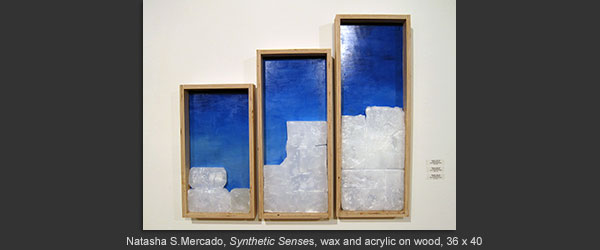
Various shapes, specifically geometric ones, have always captured my attention visually and prompted my sense of touch. During my trip this past summer to Bolivia, South America, I had the privilege to visit the ancient ruins of Tiahuanaco where I saw recently excavated stone pieces of hand built temples and huge arenas surrounded by thick stone walls used for games and sacrifices. I remember walking through these ruins and feeling the different texture patterns on the stone walls while being captivated by the various vivid colors against the wide blue sky. As I ran my fingers through the small bumps and finely cut stone squares I grasped a better sense of how these shapes were built.
Like Gabriel Orozco I want to create an interactive sculpture that is both visually appealing and also contains qualities that invites the viewer to use their sense of touch. By working from memory of my own sense of touch and incorporating those textures I felt against the Tiahuanaco stone walls, I want my work to represent the idea that what something looks like is not always what it feels like and that there is always a deeper story behind its creation. Like Giuseppe Penone I will create an organic-looking texture by bringing attention to the synthetic ground or material, in this case the wax. In the words of Susanna Starr, I want my work to “embrace a general feel and understanding of the natural organic form and then to create and modify this in an appropriate way through space and texture”.
Shannon Rafferty
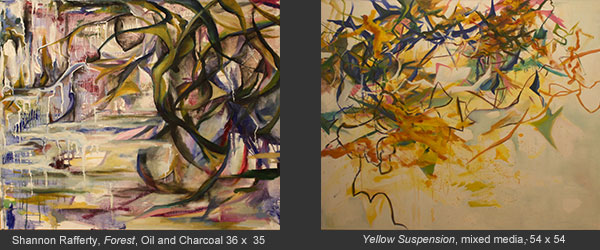
When beginning a painting, I strive to remember the unexpected rhythms of natural spaces and the juxtaposing visual movements that make up their forms. I do not start with a preconceived notion of the final image, but instead respond to both place and my working surface, building up layers of material. The gestures of my marks attempt to answer the big movements of my observational experience.
My work is rooted in intense periods of looking in order to increase my awareness of place and sensitivity to the environment. When taken away from direct observation, the marks I make lose the specificity of the place, becoming generic. I am interested in creating pockets of space amidst organic gestures that mimic the structures of a landscape and also provide visual rest. By directly observing natural forms, I am able to layer gestures from memory, creating spaces that visually recede next to moments where entry into an area is obstructed. Through this process of superimposing remembered and observed rhythms with my intuitive reaction to those marks, the canvas becomes a new visual experience.
Gretshelle Rivera
Pages from The Skylight Companion book

Narrative is a tool that can find peace within a tumultuous society. The whimsical atmosphere of my storybook illustrations reflects my dark yet playful interpretations of the chaotic world outside of my mind. The characters I create emphasize the irrational social roles forced on both men and women. I take female characters and imbue human characteristics (since a lot of popular movies portray shallow female characters that need a man to be a person) and take charge of their lives while some males have feminine traits and even contend for these habits- such as keeping clean, doing laundry and cooking. I playfully frame my gender swapped heroines with illustrated windows into a dark and whimsical environments, similarly to how large and intricate the world and its inhabitants are.
Much like the illustration artist Paula Rego, I see illustrations as narratives that represent the reflection of the emotional and physical reality. My characters and stories are driven by my own reactions from real life instances. The characters are vehicles that explore social inconsistencies and I try to find some resolution through stories.
Will Raulins
Submerged
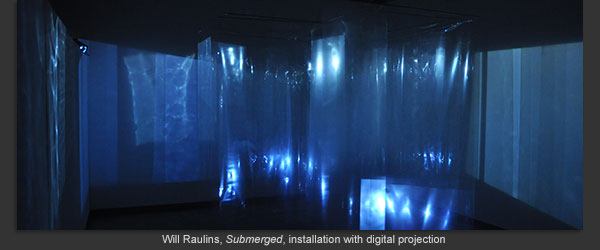
I’m interested in creating a haptic experience through an interactive time-based projected installation. I aim to engage my audience’s senses of sight, touch, and hearing in order to fully encapsulate them. I’m attempting to instill into the viewer a sense of time as my projected video progresses. Thematically, I focus on water, specifically large oceanic waves. I project onto semi-transparent mylar films, separating what would otherwise be a flat image into three dimensional space in order to simulate the visual aesthetics of a crashing wave. My long term goal which will be incorporated into my final SMP will use touch interaction via Xbox Kinect to enable the participant to complete the touch element of the artwork.
Kristin Seymour
Terrapin Soup
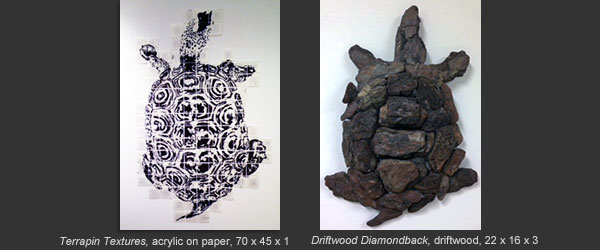
I am interested in making art that explores the relationship between art and science, more specifically nature and the textures that exist within living organisms. The Diamondback Terrapin, more specifically my pet Terp names Squirt, and photography are the subjects for my artwork. The Diamondback Terrapin Malaclemys Terrapin is species of aquatic turtle with a deep history. Many people know it as a “Terp” due to its popularity as the Maryland state animal and as a mascot. The name “terrapin” comes from a word meaning “edible turtle”. In the 18th and 19th century the terrapin populations were decimated due to the popularity of Terrapin soup. The Terrapin is unique because of the structure of their shells. Their shells are segmented into scutes (plates) consisting of a diamond shaped pattern that is unique to each turtle, much like a human’s fingerprint. Their skin is tan or silver filled with dotted or dashed black designs, also unique to each animal. It is these unique designs that were the inspiration for this series of artwork.
The textures and shapes formed on the Terp’s body are artistic in their original form, but I choose to push these designs further with my art. I do this through photography, digital art and sculpture. This series is meant to be an analysis of photography as a medium and process. Simply taking a photograph, collapses a three-dimensional space into a two dimensional image. I further flatten the photograph into a digital graphic design. Then I expand the process once more to make a new three-dimensional representation of the graphic image based on the original photograph. I do this through the use of segmentation in multiple different forms to create sculptures.
Caiti Sullivan

There is an intangible relationship between humans and the landscapes around us. Like us, land is a site of production as well as an entity that can have powers of ownership and creation. In my work I investigate what it means to produce, use, claim, and own through sites that I find and create. Sometimes, my work is my action: I perform domestic human rituals of burial, baptism, and production in physical places like fields, kitchens, and forests. I also create sculptural sites from tools, furniture, clothing, earth elements, and light to merge human and natural landscapes. I spend a lot of time observing landscapes and photographing where they have (or haven’t) interacted with human constructions. My actions, documents, and constructions explore the significance of production and ownership. I wonder, what power is gained through the control of an entity that can produce, sustain, and claim life itself?
Charles Wacker
Civic Toll
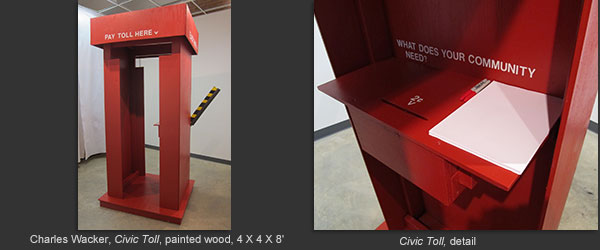
I am a mixed media artist currently investigating interactive public art. My interactive installation work titled Civic Toll, uses the aesthetic vocabulary of a tollbooth to give audience members a chance to participate in democratic life by putting forth their individual voice. Here, I propose the analogy of paying a toll to being an active civic member. It is my personal belief that community members should feel the obligation to contribute to the social structures of which they are the benefactors, sustaining and enhancing these structures by taking the time to “put their two cents in”.
To me, art is dialogue. It is a platform of language that allows individuals to share their personal thoughts and experiences in a safe and sincere atmosphere. Additionally, art is a place of personal control in a seemingly chaotic world. Engaging in an art practice is an exercise involving personal responsibility and agency as well as an opportunity to observe a whole spectrum of distinct and unique perspectives. Through this process, connections are formed, commonalities are illuminated, and mutually beneficial interactions are nurtured. Through public art, new possibilities can emerge which can work to strengthen the community ideals of love and respect for all.
|
